
Victorian Tortoiseshell Card Case with Ivory Trim: Panelled Design
A Victorian tortoiseshell card case, panelled, with ivory trim. 10.5 x 7.5 cm.

Regency Tortoise Shell and Ivory Card Case with Silver Panel
Regency tortoise shell and ivory card case, of rectangular form, the push button clasp releasing a hinged cover decorated with ivory borders and upper silver panel, 10 cm x 7.5 cm note: this lot can only be shipped within Australia

19th Century Carved Ivory Card Case with Village Scene
Antique carved ivory card case, profusely carved 19th century ivory card case decorated with village scene

Chinoiserie Carved Ivory Card Case with Detailed Miniature Decoration
Carved ivory card case, carved ivory with ornate miniature detailed Chinoiserie decoration within cross shape, length 8.5, width 4.8 cm

Intricate Ivory: Exquisite Antique Card Case, 10.5 cm Height
An elaborately carved antique ivory card case, height 10.5 cm

Antique Tortoiseshell Calling Card Case with Silver Inlay
An antique calling card case, tortoiseshell and ivory inlaid with sterling silver, 19th century, 10.5 cm x 7.5 cm
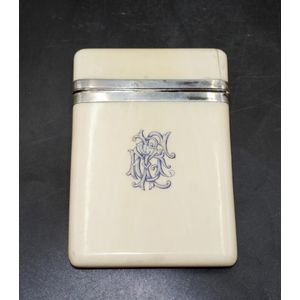
Antique Ivory Card Case with Hinged Lid
Antique ivory card case with hinged lid, 10.5 x 7.5 cm approx..

Carved ivory card case with pages and pen
19th century carved ivory card case, of rectangular form, set with ivory pages and pen, height 10 cm

Elegant 19th Century Silver Card Case with Mother of Pearl
Superb ladies 19th century card case, in silver, mother of pearl and tortoise shell. The interior fited with card segments and ivory lining

19th Century Chinese Ivory Card Case with Carved Panels
Late circa 19th century Chinese ivory calling card case with 4 carved panels depicting figures in a landscape

Sterling Silver Card Case and Ivory Aide-Memoire Set
A sterling silver card case and an ivory aide-memoire, 1891 Birmingham, with maker's mark for George Unite (case), 19th/20th century, a pretty card case delicately engraved throughout with a variety of fern species, hallmarked, and an aide-memoire with…

Anglo-Indian Ivory and Sandalwood Card Case with Carvings
A 19th century Anglo-Indian ivory and sandalwood card case, with finely carved reticulated ivory overlay on a horn body. Shield to center inscribed 'HMS' to one side and on the other a Garuda. 12 x 8 x 2 cm.

1900 Ivory Card Case with Spring Hinged Cover
Antique ivory card case c.1900. With spring hinged cover. Height 11 cm, W7.5 cm
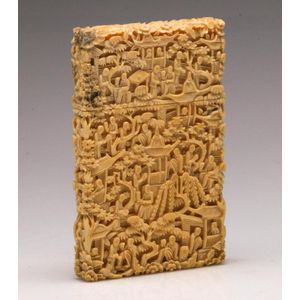
Exquisite Ivory Card Case with Intricate Carvings
Intricately carved ivory card case 10.5 cm x 7.5 cm
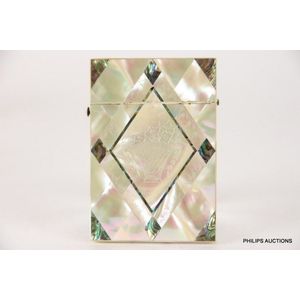
Victorian Mother-of-Pearl & Abalone Visiting Card Case
A Victorian mother-of-pearl and abalone shell visiting card case, later 19th century, the case with diamond shaped mother-of-pearl tiles and abalone shell details, a large diamond motif to the face engraved with a basket of flowers enclosed by abalone…

Antique Tortoiseshell Calling Card Case with Mother of Pearl Trim
An antique calling card case, tortoiseshell and mother of pearl with ivory trim and silk lining, 19th century, 10 cm high

Ivory Card Case with Monogram and Silk Interior
A fine ivory card case with engraved monogram H.S.R., interior fitted with blue silk accordion compartments, 19th century, 11 cm high

Elaborate Ivory Card Case: Intricate Carvings, 11.5 cm Length
Heavily carved ivory card case, length 11.5 cm
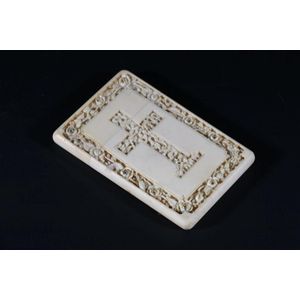
Ornate Ivory Card Case with Crucifix
Elaborately carved ivory card case with crucifix, length 11.5 cm

Victorian Mother of Pearl Card Case with Floral Inlay
A Victorian tortoise shell & inlay mother of pearl card case, with floral pattern & ivory detail, break & missing part to clasp, 9 x 7 x 1.5 cm

Victorian Ivory Card Case with Village and Fish Carvings
Victorian carved ivory calling card case, finely carved with village scene and fish of the ocean (faults)

Multi-Compartment Ivory Card Case with Pencil
An Edwardian ivory card case holder, opens up to reveal multiple compartments, with pencil

19th Century English Tortoiseshell Card Case with Inlay
An antique card case, tortoiseshell and ivory with mother of pearl inlay, English, 19th century, 9.5 cm high
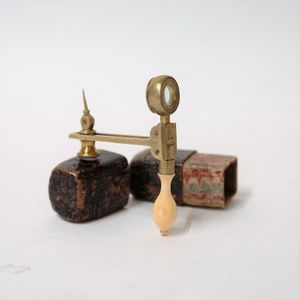
Brass and Ivory Folding Pocket Map Reader
An early 19th century brass and ivory handled folding pocket map reader, the circular viewing lens and handle folding into original pressed two-section card case, length 5 cm (of reader).
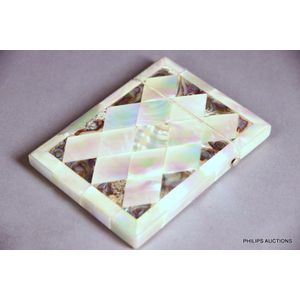
Victorian Mother-of-Pearl and Abalone Card Case
A Victorian Mother-of-Pearl and Abalone Visiting card case, 19th century, a rectangular hinge top case diagonally set with mother-of-pearl tiles bordered by a chevron arrangement of abalone tiles, with a press button opening mechanism revealing the ivory…

Victorian Mother-of-Pearl Visiting Card Case
A Victorian Mother-of-Pearl Visiting card case, 19th century, the rectangular hinge top case diagonally set with mother-of-pearl tiles finely engraved with patterns and floral motifs, with a press button opening mechanism revealing the ivory tipped edges…

Persian-style Ivory Card Case from Flower Family Collection
A small finely carved ivory card case, the exterior profusely carved in the Persian manner. 5 cm x 8.5 cm. Provenance: The Flower Family Collection.

Ivory Card Case with Ebony Ring and Glass Beads
A small plain ivory card case, set with a small inlaid ring of ebony mounted with five small glass beads. 5 cm x 8.5 cm. Provenance: The Flower Family Collection.
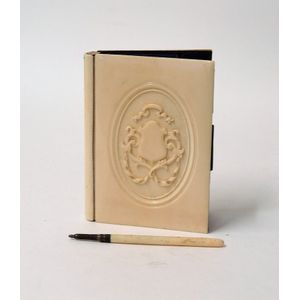
Victorian Ivory Card Case with Bone Pencil and Silk Interior
A Victorian ivory covered card case, the front with oval cartouche incorporating a vacant shield framed by scroll and wrythen forms, the bone handled pencil removable revealing the watered silk-lined sectional interior. Provenance: The Flower Family…

19th Century Tortoiseshell Visiting Card Case with Ivory Edges
A 19th century tortoiseshell visiting card case, the hinged lid opening to reveal ivory clashed edges. 10.5 cm x 7.5 cm

Victorian Tortoiseshell Card Case with Ivory Detail
A Victorian tortoiseshell card case, with hinged lid and fine ivory clashed detail at the opening. 10 cm x 7.5 cm
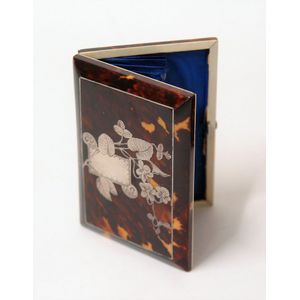
Victorian Tortoiseshell Inlaid Silver Card Case with Silk Interior
A Victorian tortoiseshell inlaid card case, the silver inlay with rectangular vacant cartouche and floral and leaf framing, the watered silk and sectional interior with ivory trim. 10.8 x 7.8 cm

Victorian Ivory Calling Card Case with Silk Lining
Victorian ivory calling card case having a two compartmental silk lined interior & a hinged clasp.

Edwardian Silver Calling Card Case with Emerald Silk Lining
An Edwardian sterling silver calling card case, 1903 Birmingham, with maker's mark for William E. Turner, engraved and bright cut with scrollwork, opening to an emerald moire silk-lined interior with pockets for calling cards and stamps, with an attached…
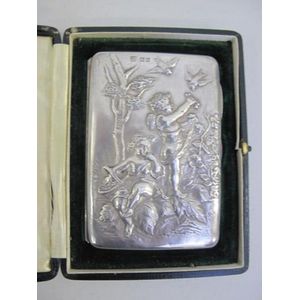
Rare Sampson Mordan Sterling Silver Card Case with Ivory Interior
Rare Sampson Mordan sterling silver card case, with ivory aide de memoire and pencil to interior, hallmarks London 1909 in original fitted leather case weighs 138grams

Georgian Pique Ivory & Silver Calling Card Case
Georgian ivory and silver pique work calling card case

Sterling Silver Card Case with Ivory Memo Sheet
A sterling silver combination card case & aide-memoir, Birmingham (rubbed hallmark), with ivory note sheet
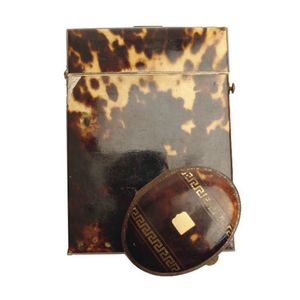
Victorian Tortoiseshell Card Case and Oval Purse
Two Victorian tortoiseshell covered items; a card case with ivory trim and push-button release, minor losses, together with an oval small purse, the steel frame with sectional chamois interior, the top tortoiseshell panel with gilt Greek key inlaid bands.

Finely Carved Ivory Card Case with Intricate Figures
An early 20th century finely carved ivory card case, all-over profuse carving of figures on verandas amongst foliage, rectangular form, slot on lid. 10.8 cm x 6.8 cm

Georgian Silver Inlaid Ivory Card Case
A Georgian ivory pique card case, early 19th century, of simple rectangular form with a push button release hinged top exquisitely inlaid throughout with a fine pattern of tiny silver dots. Length 9 cm. Width 5 cm

Carved Ivory Card Case with Cross Design
Antique carved ivory card case, cross verso. Approx 9.5 cm long, 6 cm wide

Antique Ivory Card Case, 19th Century
19th century carved ivory card case, approx 9.5 cm long, 5.5 cm wide

Islamic Pierced Ivory Card Case
An Islamic pierced ivory card case, early to mid 20th century, having a fitted removable lid, and pierced in dots and tear drops in various floral and circular designs, the pieces of the case joined with petite pins, length 8.5 cm. Width 5 cm

Victorian Tortoiseshell Card Case with Ivory Fittings
A Victorian tortoiseshell covered card case, the hinged lid with push-button release revealing ivory fittings, rectangular form, good condition and polish. 7.2 cm x 1 cm x 10.4 cm

Inlaid Sandalwood Card Case with Geometric and Floral Design
An Edwardian sandalwood and inlaid card case, rectangular form, the exterior inlaid with ivory, ebony and dyed ivory geometric and floral forms.

Edwardian Silver Card Case with Floral Embossing and Crown Engraving
An Edwardian silver card case, Goldsmith & Silversmith Company Limited, London 1908 of rectangular form with embossed floral, shell and scrolled decoration with central cartouch, one engraved with a crown the other empty, with origianl fitted leather and…

Victorian Tortoiseshell Visiting Card Case
A Victorian ladies visiting card case in tortoiseshell with ivory band and silver catch. Height 10.5 cm. Width 8 cm

Carved Ivory Card Case with Figurative Panels
A carved ivory card case, one side carved with two leaf shaped panels depicting figures in landscapes, the other side with a cruciform panel similarly carved. Repaired split. 11 x 6.7 cm


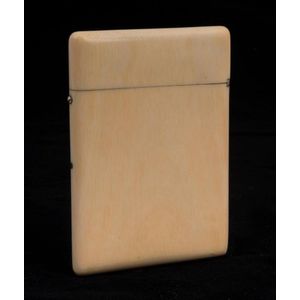





 Loading more...
Loading more...